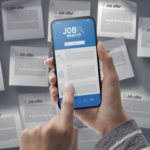There are many stages in recruitment when a potential hire applies for a role. The CV or cover letter needs to be reviewed, and from there, they may have two or three rounds of interviews. If offered a job, conversations around salary and onboarding and training begin. Then it’s the employers’ job to foster and retain loyalty. All these steps aren’t quick, easy, or cheap to go through and a business may need to go through at least 20 candidates before finding the right person.
This is where Artificial Intelligence (AI) comes in – a solution that can reduce the hours and energy spent in the initial recruitment process. It can help process data more quickly and remove unconscious biases, but how can businesses utilise it to truly make a difference?
Reducing costs, improving efficiencies
AI-driven recruiting software reduces costs by processing large volumes of data quickly. AI also allows for more engaging and user-friendly interactions between hirers and candidates, automated high volume administrative tasks, elevated employer brand and adherence to diversity, inclusion, and equality practices. A global survey conducted by Korn Ferry found that 63% of acquisition professionals reported an improvement in hiring practices since implementing AI tools for the effect.
The biggest advantage of recruiting with AI is the time saved. Talent acquisition teams typically have 30 – 40 open job requisitions at any one time, according to the Society for Human Resource Management. Most of these receive upwards of 250 resumes, each taking recruiters an average of 23 hours to sift through. All these hours could be spent improving HR processes, strategising ways to improve systems in place within the company, as well as planning and conducting more thorough evaluations at the interview stage.
There are concerns that AI tools could infringe privacy rights, such as facial recognition, which could be considered unethical and beyond the needs required to appoint candidates. Other concerns include a lack of human interaction and human judgement, and biases creeping in at all stages from programming to managing algorithms. These partialities, however, have a human origin and shouldn’t necessarily be blamed on the software. It’s who builds it that has prejudices, not the algorithms.
Make better decisions
According to the Cognitive Bias Codex, humans are subject to more than 180 cognitive biases in traditional hiring practices, from reviewing an applicant’s information, to interview selection, to conducting interviews and selecting a candidate for the position. With so many unconscious biases actively influencing our decisions daily, it’s important to consider solutions that might help make better and fairer decisions.
Although AI is helpful in speeding up the hiring process, it’s not without its faults if implemented incorrectly. There can be biases in AI when there isn’t a representative data set or a number of characteristics agreed upon. When AI is created, humans have to code it. It’s in this part of the process that human biases can be built into the algorithm. However, this will show up in patterns found in legacy recruitment data. The longer the talent acquisition history, the more AI-powered process can learn, preferences removed, and function ‘re-educated’.
There are also solutions to circumvent these issues. Having two algorithms, for example, working in parallel can mitigate bias. The first algorithm selects a candidate based on a specific data set skills required. The second becomes responsible for underlying sensitive attributes, such as gender, age, race, and academic qualifications. Another useful technique is post-processing, designed to take inherently biased results, and recast them fairly and accurately. For example, if the distribution of gender isn’t equal, one gender might be ranked higher, unfairly – in that case, the system readjusts, so each applicant has the same chance to be reviewed and considered.
Meeting business goals
The success of any business transformation project is the ability to ensure it’s right for the company, is scalable, and focuses on outcomes. When looking for a partner to help implement AI, organisations must look to a reputable and trustworthy source so they can work together at every stage of the journey.
AI is no longer talk of the future, we can implement it now and see real outcomes. Forward-thinking businesses that successfully adopt new technological measures can reap the benefits of more efficient and less costly hiring measures.









